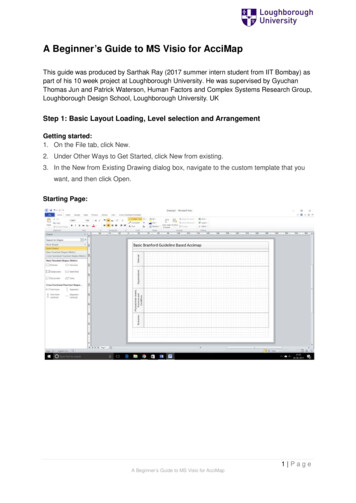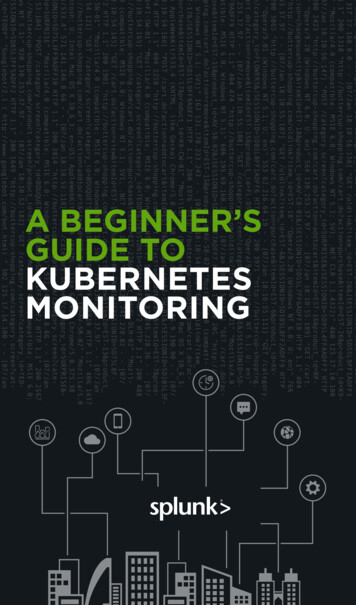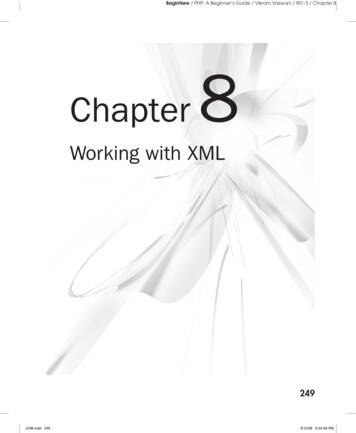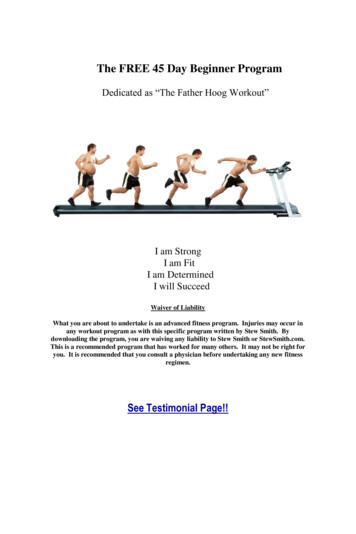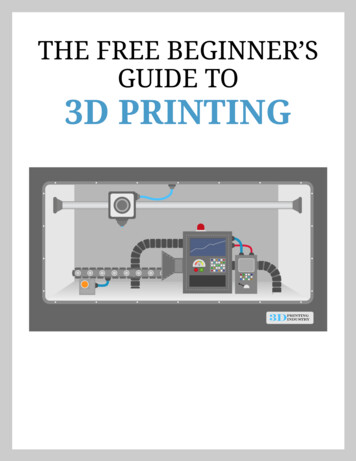
Transcription
THE FREE BEGINNER’SGUIDE TO3D PRINTING
Table of ContentsChapter 01 : Introduction: What is 3D printing?05Chapter 02 : History of 3D Printing10Chapter 03 : 3D Printing Technology19Chapter 04 : 3D Printing Processes24Chapter 05 : 3D Printing Materials40Chapter 06 : 3D Printing Global Effects48Chapter 07 : 3D Printing Benefits & Value53Chapter 08 : 3D Printing Applications57Glossary72
3D Printing Basics:Welcome to 3DPI’s Beginner’s Guide to 3D Printing. Whether youare new to 3D printing technology or just looking to close a fewknowledge gaps, we’re glad you stopped by. By now, most of ushave heard, at some level, about the potential of 3D printing. Butwith this guide we are offering insights into the history and thereality of 3D printing — the processes, materials and applications —as well as measured thoughts on where it might be heading.!We hope you’ll find this to be one of the most comprehensive 3Dprinting resources available, and that no matter what your skill levelis, there will be plenty in here to meet your needs. As an addedbonus, we’re working on a handy downloadable PDF version of theentire guide, and hope to have that ready very soon.!Are you ready? Let’s get started!3D Printing — also known as additive manufacturing — hasbeen quoted in the Financial Times and by other sources aspotentially being larger than the Internet. Some believe this istrue. Many others urge that this is part of the extraordinaryhype that exists around this very exciting technology area. Sowhat really is 3D printing, who generally uses 3D printers andwhat for?!33dprintingindustry.com
OverviewThe term 3D printing covers ahost of processes andtechnologies that offer a fullspectrum of capabilities for theproduction of parts andproducts in different materials.Essentially, what all of theprocesses and technologiescommentators on thishave in common is the mannertechnology sector agree that,in which production is carriedas of today, we are only justout — layer by layer in anbeginning to see the trueadditive process — which is inpotential of 3D printing. 3DPI, acontrast to traditional methodsreliable media source for 3Dof production involvingprinting, brings you all of thesubtractive methods orlatest news, views, processmoulding/casting processes.developments and applicationsApplications of 3D printing areas they emerge in this excitingemerging almost by the day,field. This overview article aimsand, as this technologyto provide the 3DPI audiencecontinues to penetrate morewith a reliable backgrounderwidely and deeply acrosson 3D printing in terms of whatindustrial, maker andit is (technologies, processesconsumer sectors, this is onlyand materials), its history,set to increase. Most reputableapplication areas and benefits.!43dprintingindustry.com
CHAPTERIntroductionWhat is 3D printing?!5
Introduction – What is 3D printing?Technology has affected recentnewspapers and across onlinehuman history probably moreresources. What really is thisthan any other field. Think of a3D printing that some havelight bulb, steam engine or,claimed will put an end tomore latterly, cars andtraditional manufacturing asaeroplanes, not to mention thewe know it, revolutionizerise and rise of the world widedesign and imposeweb. These technologies havegeopolitical, economic, social,made our lives better in manydemographic, environmentalways, opened up new avenuesand security implications toand possibilities, but usually itour every day lives?takes time, sometimes even!decades, before the trulyThe most basic, differentiatingdisruptive nature of theprinciple behind 3D printing istechnology becomes apparent.that it is an additive!manufacturing process. AndIt is widely believed that 3Dthis is indeed the key becauseprinting or additive3D printing is a radicallymanufacturing (AM) has thedifferent manufacturingvast potential to become onemethod based on advancedof these technologies. 3Dtechnology that builds upprinting has now been coveredparts, additively, in layers atacross many televisionthe sub mm scale. This ischannels, in mainstreamfundamentally different from!63dprintingindustry.com
Introduction – What is 3D printing?any other existing traditionalwhether to achieve the endmanufacturing techniques.product itself or to produce a!tool for casting or mouldingThere are a number ofprocesses — and this is alimitations to traditionalserious limitation within themanufacturing, which hasoverall manufacturing process.widely been based on human!labour and “made by hand”For many applicationsideology rooting back to thetraditional design andetymological origins of theproduction processes impose aFrench word for manufacturingnumber of unacceptableitself. However, the world ofconstraints, including themanufacturing has changed,expensive tooling asand automated processes suchmentioned above, fixtures, andas machining, casting, formingthe need for assembly forand moulding are all (relatively)complex parts. In addition, thenew, complex processes thatrequire machines, computersand robot technology.!However, these technologiesall demand subtractingmaterial from a larger block —!73dprintingindustry.com
Introduction – What is 3D printing?subtractive manufacturingunprecedented designprocesses, such as machining,freedom while being a tool-lesscan result in up to 90% of theprocess that reducesoriginal block of material beingprohibitive costs and leadwasted.times. Components can be!designed specifically to avoidIn contrast, 3D printing is aassembly requirements withprocess for creating objectsintricate geometry anddirectly, by adding materialcomplex features created at nolayer by layer in a variety ofextra cost. 3D printing is alsoways, depending on theemerging as an energy-technology used. Simplifyingefficient technology that canthe ideology behind 3Dprovide environmentalprinting, for anyone that is stillefficiencies in terms of bothtrying to understand thethe manufacturing processconcept (and there are many),itself, utilising up to 90% ofit could be likened to thestandard materials, andprocess of building somethingthroughout the product’swith Lego blocks automatically.operating life, through lighter!and stronger design.3D printing is an enabling!technology that encouragesIn recent years, 3D printing hasand drives innovation withgone beyond being an!83dprintingindustry.com
Introduction – What is 3D printing?industrial prototyping and manufacturing process as thetechnology has become more accessible to small companies andeven individuals. Once the domain of huge, multi-nationalcorporations due to the scale and economics of owning a 3Dprinter, smaller (less capable) 3D printers can now be acquired forunder 1000.!This has opened up the technology to a much wider audience,and as the exponential adoption rate continues apace on allfronts, more and more systems, materials, applications, servicesand ancillaries are emerging.!93dprintingindustry.com
CHAPTERHistory of 3D Printing!10
History of 3D PrintingThe earliest 3D printing technologies firstbecame visible in the late 1980’s, at whichtime they were called Rapid Prototyping(RP) technologies. This is because theprocesses were originally conceived as afast and more cost-effective method forcreating prototypes for productdevelopment within industry. As aninteresting aside, the very first patentapplication for RP technology was filed by aDr Kodama, in Japan, in May 1980.Unfortunately for Dr Kodama, the fullpatent specification was subsequently notfiled before the one year deadline after theapplication, which is particularly disastrousconsidering that he was a patent lawyer! Inreal terms, however, the origins of 3Dprinting can be traced back to 1986, whenthe first patent was issued forstereolithography apparatus (SLA). Thispatent belonged to one Charles (Chuck)Hull, who first invented his SLA machine in1983. Hull went on to co-found 3D SystemsCorporation — one of the largest and most!113dprintingindustry.com
History of 3D Printingprolific organizations operating in the 3Dprinting sector today.!3D Systems’ first commercial RP system, theSLA-1, was introduced in 1987 and followingrigorous testing the first of these systemwas sold in 1988. As is fairly typical withnew technology, while SLA can claim to bethe first past the starting post, it was notthe only RP technology in development atthis time, for, in 1987, Carl Deckard, whowas working at the University of Texas, fileda patent in the US for the Selective LaserSintering (SLS) RP process. This patent wasissued in 1989 and SLS was later licensed toDTM Inc, which was later acquired by 3DSystems. 1989 was also the year that ScottCrump, a co-founder of Stratasys Inc. filed apatent for Fused Deposition Modelling(FDM) — the proprietary technology that isstill held by the company today, but is alsothe process used by many of the entry-levelmachines, based on the open sourceRepRap model, that are prolific today. The FDM patent was issuedto Stratasys in 1992. In Europe, 1989 also saw the formation of!123dprintingindustry.com
History of 3D PrintingEOS GmbH in Germany,emerging during these years,founded by Hans Langer. Afternamely Ballistic Particlea dalliance with SL processes,Manufacturing (BPM) originallyEOS’ R&D focus was placedpatented by William Masters,heavily on the laser sinteringLaminated Object(LS) process, which hasManufacturing (LOM) originallycontinued to go from strengthpatented by Michael Feygin,to strength. Today, the EOSSolid Ground Curing (SGC)systems are recognized aroundoriginally patented by Itzchakthe world for their qualityPomerantz et al and ‘threeoutput for industrialdimensional printing’ (3DP)prototyping and productionoriginally patented by Emanuelapplications of 3D printing.Sachs et al. And so the earlyEOS sold its first ‘Stereos’nineties witnessed a growingsystem in 1990. The company’snumber of competingdirect metal laser sinteringcompanies in the RP market(DMLS) process resulted frombut only three of the originalsan initial project with a divisionremain today — 3D Systems,of Electrolux Finland, whichEOS and Stratasys.was later acquired by EOS.!!Throughout the 1990’s andOther 3D printing technologiesearly 2000’s a host of newand processes were alsotechnologies continued to be!133dprintingindustry.com
History of 3D Printingntroduced, still focused whollyTechnologies (an establishedon industrial applications andvacuum casting OEM)while they were still largelyintroduced the SLM technologyprocesses for prototypingin 2000, EnvisionTec wasapplications, R&D was alsofounded in 2002, ExOne wasbeing conducted by the moreestablished in 2005 as a spin-advanced technology providersoff from the Extrude Honefor specific tooling, casting andCorporation and Sciaky Inc wasdirect manufacturingpioneering its own additiveapplications. This saw theprocess based on itsemergence of newproprietary electron beamterminology, namely Rapidwelding technology. TheseTooling (RT), Rapid Casting andcompanies all served to swellRapid Manufacturing (RM)the ranks of Westernrespectively.companies operating across a!global market. The terminologyIn terms of commercialhad also evolved with aoperations, Sanders Prototypeproliferation of manufacturing(later Solidscape) andapplications and the acceptedZCorporation were set up inumbrella term for all of the1996, Arcam was established inprocesses was Additive1997, Objet GeometriesManufacturing (AM). Notably,launched in 1998, MCPthere were many parallel!143dprintingindustry.com
History of 3D Printingdevelopments taking place inapplications across thethe Eastern hemisphere.aerospace, automotive,However, these technologies,medical and fine jewellerywhile significant in themselvessectors, as years of R&D andand enjoying some localqualification are now payingsuccess, did not really impactoff. A great deal still remainsthe global market at that time.behind closed doors and/or!under non-disclosureDuring the mid noughties, theagreements (NDA). At the othersector started to show signs ofend of the spectrum, some ofdistinct diversification with twothe 3D printing systemspecific areas of emphasis thatmanufacturers wereare much more clearly defineddeveloping and advancingtoday. First, there was the high‘concept modellers’, as theyend of 3D printing, still verywere called at the time.expensive systems, which wereSpecifically, these were 3Dgeared towards partprinters that kept the focus onproduction for high value,improving concepthighly engineered, complexdevelopment and functionalparts. This is still ongoing —prototyping, that were beingand growing — but the resultsdeveloped specifically as office-are only now really starting toand user-friendly, cost-effectivebecome visible in productionsystems. The prelude to!153dprintingindustry.com
History of 3D Printingtoday’s desktop machines.influences. The holy grail atHowever, these systems werethat time was to get a 3Dall still very much for industrialprinter under 5000 — thisapplications.was seen by many industry!insiders, users andLooking back, this was reallycommentators as the key tothe calm before the storm.opening up 3D printing!technology to a much widerAt the lower end of the marketaudience. For much of that— the 3D printers that todayyear, the arrival of the highly-are seen as being in the midanticipated Desktop Factory —range — a price war emergedwhich many predicted wouldtogether with incrementalbe the fulfillment of that holyimprovements in printinggrail — was heralded as theaccuracy, speed and materials.one to watch. It came to!nothing as the organizationIn 2007, the market saw thefaltered in the run up tofirst system under 10,000production. Desktop Factoryfrom 3D Systems, but thisand its leader, Cathy Lewis,never quite hit the mark that itwere acquired, along with thewas supposed to. This wasIP, by 3D Systems in 2008 andpartly due to the system itself,all but vanished. As it turnedbut also other marketout though, 2007 was actually!163dprintingindustry.com
History of 3D Printingthe year that did mark theBut it wasn’t until January 2009turning point for accessible 3Dthat the first commerciallyprinting technology — evenavailable 3D printer – in kitthough few realized it at theform and based on the RepRaptime — as the RepRapconcept – was offered for sale.phenomenon took root. DrThis was the BfB RapMan 3DBowyer conceived the RepRapprinter. Closely followed byconcept of an open source,Makerbot Industries in Aprilself-replicating 3D printer asthe same year, the founders ofearly as 2004, and the seedwhich were heavily involved inwas germinated in thethe development of RepRapfollowing years with someuntil they departed from theheavy slog from his team atOpen Source philosophyBath, most notably Vik Oliverfollowing extensive investment.and Rhys Jones, whoSince 2009, a host of similardeveloped the concept throughdeposition printers haveto working prototypes of a 3Demerged with marginal uniqueprinter using the depositionselling points (USPs) and theyprocess. 2007 was the year thecontinue to do so. Theshoots started to showinteresting dichotomy here isthrough and this embryonic,hat, while the RepRapopen source 3D printingphenomenon has given rise tomovement started to gaina whole new sector ofvisibility.commercial, entry-level 3D!173dprintingindustry.com
History of 3D Printingprinters, the ethos of thein awareness and uptakeRepRap community is all aboutacross a growing makerOpen Source developments formovement, 2012 was also the3D printing and keepingyear that many differentcommercialization at bay.mainstream media channels!picked up on the technology.2012 was the year that2013 was a year of significantalternative 3D printinggrowth and consolidation. Oneprocesses were introduced atof the most notable moves wasthe entry level of the market.the acquisition of Makerbot byThe B9Creator (utilising DLPStratasys.technology) came first in June,!followed by the Form 1Heralded as the 2nd, 3rd and,(utilising stereolithography) insometimes even, 4th IndustrialDecember. Both wereRevolution by some, whatlaunched via the funding sitecannot be denied is the impactKickstarter — and boththat 3D printing is having onenjoyed huge success.the industrial sector and the!huge potential that 3D printingAs a result of the marketis demonstrating for the futuredivergence, significantof consumers. What shape thatadvances at the industrial levelpotential will take is stillwith capabilities andunfolding before us.applications, dramatic increase!183dprintingindustry.com
CHAPTER3D Printing Technology!19
3D Printing TechnologyThe starting point for any 3Dceramics and sand are, now, allprinting process is a 3D digitalroutinely used for industrialmodel, which can be createdprototyping and productionusing a variety of 3D softwareapplications. Research is alsoprogrammes — in industry thisbeing conducted for 3Dis 3D CAD, for Makers andprinting bio materials andConsumers there are simpler,different types of food.more accessible programmesGenerally speaking though, atavailable — or scanned with athe entry level of the market,3D scanner. The model is thenmaterials are much more‘sliced’ into layers, therebylimited. Plastic is currently theconverting the design into a fileonly widely used material —readable by the 3D printer. Theusually ABS or PLA, but therematerial processed by the 3Dare a growing number ofprinter is then layeredalternatives, including Nylon.according to the design andThere is also a growing numberthe process. As stated, thereof entry level machines thatare a number of different typeshave been adapted forof 3D printing technologies,foodstuffs, such as sugar andwhich process differentchocolate.materials in different ways tocreate the final object.Functional plastics, metals,!203dprintingindustry.com
How it WorksThe different types of 3Dprinters each employ adifferent technology thatprocesses different materialsin different ways. It isimportant to understand thatone of the most basiclimitations of 3D printing — interms of materials andStart with a 3D CAD file eitherby creating the 3D model orscanned with a 3D scannerapplications — is that there isno ‘one solution fits all’. Forexample some 3D printersprinting process, reminiscentprocess powdered materialsof 2D inkjet printing, but with(nylon, plastic, ceramic, metal),superior materials to ink and awhich utilize a light/heatbinder to fix the layers.source to sinter/melt/fusePerhaps the most commonlayers of the powder togetherand easily recognized processin the defined shape. Othersis deposition, and this is theprocess polymer resinprocess employed by thematerials and again utilize amajority of entry-level 3Dlight/laser to solidify the resinprinters. This process extrudesin ultra thin layers. Jetting ofplastics, commonly PLA or ABS,fine droplets is another 3D!213dprintingindustry.com
How it Worksnegating the need forassembly.!However, another importantpoint to stress is that none ofthe 3D printing processescome as plug and play optionsas of today. There are manysteps prior to pressing printand more once the part comesLayer by layer the printer willcreate the predeterminedshapeoff the printer — these areoften overlooked. Apart fromthe realities of designing for 3Din filament form through aprinting, which can beheated extruder to form layersdemanding, file preparationand create the predeterminedand conversion can also proveshape.time-consuming and!complicated, particularly forBecause parts can be printedparts that demand intricatedirectly, it is possible tosupports during the buildproduce very detailed andprocess. However there areintricate objects, often withcontinual updates andfunctionality built in andupgrades of software for these!223dprintingindustry.com
How it Worksfunctions and the situation is improving. Furthermore, once offthe printer, many parts will need to undergo finishing operations.Support removal is an obvious one for processes that demandsupport, but others include sanding, lacquer, paint or other typesof traditional finishing touches, which all typically need to be doneby hand and require skill and/or time and patience.You will soon start to seethe object become morerecognizableAt the end of the printprocess you will have yourfinalized object!233dprintingindustry.com
CHAPTER3D Printing Processes!24
StereolithographyStereolithography (SL) is widely recognized as the first 3D printingprocess; it was certainly the first to be commercialised. SL is alaser-based process that works with photopolymer resins, thatreact with the laser and cure to form a solid in a very precise wayto produce very accurate parts. It is a complex process, but simplyput, the photopolymer resin is held in a vat with a movableplatform inside. A laser beam is directed in the X-Y axes across thesurface of the resin according to the 3D data supplied to themachine (the .stl file), whereby the resin hardens precisely wherethe laser hits the surface. Once the layer is completed, theplatform within the vat drops down by a fraction (in the Z axis)and the subsequent layer is traced out by the laser. Thiscontinues until the entire object is completed and the platformcan be raised out of the vat for removal.!253dprintingindustry.com
StereolithographyBecause of the nature of the SL process, it requires supportstructures for some parts, specifically those with overhangs orundercuts. These structures need to be manually removed.!In terms of other post processing steps, many objects 3D printedusing SL need to be cleaned and cured. Curing involves subjectingthe part to intense light in an oven-like machine to fully hardenthe resin.!Stereolithography is generally accepted as being one of the mostaccurate 3D printing processes with excellent surface finish.However limiting factors include the post-processing stepsrequired and the stability of the materials over time, which canbecome more brittle.!263dprintingindustry.com
DLPDLP — or digital light processing — is a similar process tostereolithography in that it is a 3D printing process that workswith photopolymers. The major difference is the light source. DLPuses a more conventional light source, such as an arc lamp, with aliquid crystal display panel or a deformable mirror device (DMD),which is applied to the entire surface of the vat of photopolymerresin in a single pass, generally making it faster than SL.!Also like SL, DLP produces highly accurate parts with excellentresolution, but its similarities also include the same requirementsfor support structures and post-curing. However, one advantageof DLP over SL is that only a shallow vat of resin is required tofacilitate the process, which generally results in less waste andlower running costs.!273dprintingindustry.com
Laser Sintering / Laser MeltingLaser sintering and laser melting are interchangeable terms thatrefer to a laser based 3D printing process that works withpowdered materials. The laser is traced across a powder bed oftightly compacted powdered material, according to the 3D datafed to the machine, in the X-Y axes. As the laser interacts with thesurface of the powdered material it sinters, or fuses, the particlesto each other forming a solid. As each layer is completed thepowder bed drops incrementally and a roller smoothes thepowder over the surface of the bed prior to the next pass of thelaser for the subsequent layer to be formed and fused with theprevious layer.!283dprintingindustry.com
Laser Sintering / Laser MeltingThe build chamber is completely sealed as it is necessary tomaintain a precise temperature during the process specific to themelting point of the powdered material of choice. Once finished,the entire powder bed is removed from the machine and theexcess powder can be removed to leave the ‘printed’ parts. One ofthe key advantages of this process is that the powder bed servesas an in-process support structure for overhangs and undercuts,and therefore complex shapes that could not be manufactured inany other way are possible with this process.!However, on the downside, because of the high temperaturesrequired for laser sintering, cooling times can be considerable.Furthermore, porosity has been an historical issue with thisprocess, and while there have been significant improvementstowards fully dense parts, some applications still necessitateinfiltration with another material to improve mechanicalcharacteristics.!Laser sintering can process plastic and metal materials, althoughmetal sintering does require a much higher powered laser andhigher in-process temperatures. Parts produced with this processare much stronger than with SL or DLP, although generally thesurface finish and accuracy is not as good.!293dprintingindustry.com
Extrusion / FDM / FFF3D printing utilizing the extrusion of thermoplastic material iseasily the most common — and recognizable — 3DP process. Themost popular name for the process is Fused Deposition Modelling(FDM), due to its longevity, however this is a trade name,registered by Stratasys, the company that originally developed it.Stratasys’ FDM technology has been around since the early 1990’sand today is an industrial grade 3D printing process. However, theproliferation of entry-level 3D printers that have emerged since2009 largely utilize a similar process, generally referred to asFreeform Fabrication (FFF), but in a more basic form due topatents still held by Stratasys. The earliest RepRap machines andall subsequent evolutions — open source and commercial —!303dprintingindustry.com
Extrusion / FDM / FFFemploy extrusion methodology. However, following Stratasys’patent infringement filing against Afinia there is a question markover how the entry-level end of the market will develop now, withall of the machines potentially in Stratasys’ firing line for patentinfringements.!The process works by melting plastic filament that is deposited,via a heated extruder, a layer at a time, onto a build platformaccording to the 3D data supplied to the printer. Each layerhardens as it is deposited and bonds to the previous layer.!Stratasys has developed a range of proprietary industrial gradematerials for its FDM process that are suitable for someproduction applications. At the entry-level end of the market,materials are more limited, but the range is growing. The mostcommon materials for entry-level FFF 3D printers are ABS andPLA.!The FDM/FFF processes require support structures for anyapplications with overhanging geometries. For FDM, this entails asecond, water-soluble material, which allows support structuresto be relatively easily washed away, once the print is complete.Alternatively, breakaway support materials are also possible,which can be removed by manually snapping them off the part.!313dprintingindustry.com
Extrusion / FDM / FFFSupport structures, or lack thereof, have generally been alimitation of the entry level FFF 3D printers. However, as thesystems have evolved and improved to incorporate dual extrusionheads, it has become less of an issue.!In terms of models produced, the FDM process from Stratasys isan accurate and reliable process that is relatively office/studiofriendly, although extensive post-processing can be required. Atthe entry-level, as would be expected, the FFF process producesmuch less accurate models, but things are constantly improving.!The process can be slow for some part geometries and layer-tolayer adhesion can be a problem, resulting in parts that are notwatertight. Again, post-processing using Acetone can resolvethese issues.!323dprintingindustry.com
Inkjet: Binder JettingThere are two 3D printing process that utilize a jetting technique.!!!!!!!!!!Binder jetting: where the material being jetted is a binder, and isselectively sprayed into a powder bed of the part material to fuseit a layer at a time to create/print the required part. As is the casewith other powder bed systems, once a layer is completed, thepowder bed drops incrementally and a roller or blade smoothesthe powder over the surface of the bed, prior to the next pass ofthe jet heads, with the binder for the subsequent layer to beformed and fused with the previous layer.!333dprintingindustry.com
Inkjet: Binder JettingAdvantages of this process, like with SLS, include the fact that theneed for supports is negated because the powder bed itselfprovides this functionality. Furthermore, a range of differentmaterials can be used, including ceramics and food. A furtherdistinctive advantage of the process is the ability to easily add afull colour palette which can be added to the binder.!The parts resulting directly from the machine, however, are not asstrong as with the sintering process and require post-processingto ensure durability.!343dprintingindustry.com
Inkjet: Material JettingMaterial jetting: a 3D printing process whereby the actual buildmaterials (in liquid or molten state) are selectively jetted throughmultiple jet heads (with others simultaneously jetting supportmaterials). However, the materials tend to be liquidphotopolymers, which are cured with a pass of UV light as eachlayer is deposited.!The nature of this product allows for the simultaneous depositionof a range of materials, which means that a single part can beproduced from multiple materials with different characteristicsand properties. Material jetting is a very precise 3D printingmethod, producing accurate parts with a very smooth finish.!353dprintingindustry.com
Selective Deposition Lamination (SDL)SDL is a proprietary 3D printing process developed andmanufactured by Mcor Technologies. There is a temptation tocompare this process with the Laminated Object Manufacturing(LOM) process developed by Helisys in the 1990’s due tosimilarities in layering and shaping paper to form the final part.However, that is where any similarity ends.!The SDL 3D printing process builds parts layer by layer usingstandard copier paper. Each new layer is fixed to the previouslayer using an adhesive, which is applied selectively according tothe 3D data supplied to the machine. This means that a muchhigher density of adhes
Jul 03, 2014 · Welcome to 3DPI’s Beginner’s Guide to 3D Printing. Whether you are new to 3D printing technology or just looking


